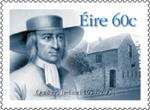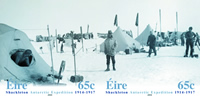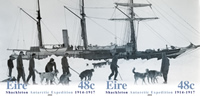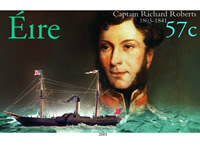
Religious Society of Friends (Quakers) in Ireland
Archive
If an event listed here turns out to have generated a script, we make it available from this archive page.
Public Events in 2004
Wednesday 14th April 2004 7.30 pmPublic Lecture Children of Light by Martin Lynn
What did the "Children of Light", one of the names used by early Quakers, stand for? The speaker's main theme was the distinctiveness of the early Quaker vision including the encounter with God's presence, the inward light, living in the spirit, and the present reality of the kingdom of heaven. The speaker explored these insights into the relationship between humankind and God, and their relevance in the vastly changed world of today.
This was at Newtown School, Waterford, as part of Yearly Meeting 2004.
Also at Yearly Meeting Miriam Logan, of Cork Meeting, spoke on the theme: Fear of Difference is at the Core of Conflict, and there was a paper entitled In and Out the Meeting House by David Butler, of Britain Yearly Meeting; David is the author and illustrator of the definitive book on Quaker Meeting Houses in Ireland, past and present.
See also Peace Project in Afghanistan, by Sue Williams, Lisburn Monthly Meeting; this talk was given in the "Irish Quaker Faith in Action" session. Sue and Stephen Williams have been deeply involved in the research, development and application of alternatives to conflict for a number of years, including a period as Residents in Quaker House Belfast.
7.30 on 17 April,
Quaker Youth Theatre Play at Garter Lane Arts Centre, Waterford
This exciting project brought together young people from all over
Ireland to put on an original play in just five days. The performance was
about Quakers in Ireland since 1654.
A future performance is planned for Lisburn on October 24.
22 April at 7.30pm
Friendly Folk Dancers - Churchtown Meeting House, Dublin;
This American group demonstrated dances from nations in conflict
24 April
Friendly Folk Dancers - South Belfast Meeting House; (as above);
the event started at 6.30 with a shared meal.
1 May from 10am to 4pm
Quaker Trail; this was led by W. Ross Chapman'
It visited some of the earliest Quaker sites in Ireland.
2 May at 3pm
"Keeping the Faith"
Talk with speaker Johan Maurer
This took place at Lurgan Meeting House, Co Armagh.
Saturday 8th May 2004
Open day at Monkstown Meeting House, Pakenham Rd, Monkstown, Dublin; everyone welcome; 11.30 to 5 pm.
There was on display a set of panels outlining the history, philosophy and current activities of Friends.
This Open Day was repeated on Saturday 5th June, Sunday 20th June, Saturday 10th July and Sunday 18th July; 1pm to 6 pm on Sundays, 11.30 to 5 pm on Saturdays.
Saturday 22nd May 2004 3.00pm
At Bessbrook Friends Meeting House, Deramore Road:
(Bessbrook is west of Newry, Co Down)
"Quakers in Bessbrook". There was a presentation, display, walk and social afternoon.
Sunday 23rd May 2004 3.00pm
Also at Bessbrook Friends Meeting House there was:
"Music in May", with Counterpoint and the choirs of St Joseph's and Bessbrook Primary Schools.
Sunday 20th June 2004
There was a open day at Monkstown Meeting House, Pakenham Rd, Monkstown, Dublin; 1pm to 6pm.
There was on display a set of panels outlining the history, philosophy and current activities of Friends.
This Open Day was repeated on Saturday 10th July and Sunday 18th July.
Friday 25th June 2004, 7 - 9.30pm.
There was an evening of three short historical talks at Kelly's Louhge, Timahoe, Offaly, with Ross Chapman Introduction to Quakers in Ireland, Therese Abbott Quakerism in the Edenderry areaand Seamus Cullen The Quakers of Timahoe.
Saturday 26th June 2004, 2pm.
There was a commemorative event at Hodgestown Quaker Burial Ground, which included the unveiling of a plaque by Rob Goodbody, and a talk on the visit of Richard Nixon to Timahoe in 1970. There was a conducted tour of historical sites in the area.
Saturday 10th July 2004
The open day at Monkstown Meeting House, Pakenham Rd, Monkstown, Dublin ran from 11.30 to 5 pm. There was again on display the set of
panels outlining the history, philosophy and current activities of Friends.
This Open Day was repeated on Sunday 18th July.
9 August at 8pm
There was a lecture on History of Quakers by Ross Chapman, in Lurgan Library, part of Lurgan's Master McGrath festival.
Sunday 5 September
Official Opening of the Quaker Museum at Ballitore, Co. Kildare.
There was an opportunity to join Ballitore Friends for Meeting for Worship at 11am, with the opening taking place at the Mary Leadbeater House in the afternoon.
Monday 6th to Friday 10th September, 9.30 to 4.30 each day.
County Hall, Marine Road, Dun Laoghaire. As part of Heritage Week, Monkstown Friends exhibited 20 specially commissioned full colour illustrated information posters telling the story of Quakers in Ireland. There was special mention of the contribution made to the heritage of the locality by Monkstown Quakers, including their part in the promotion of the Dublin to Kingstown Railway. Admission Free.
17 September at 7.30pm
Public Lecture on past and present Quakers in Ireland by Philip Jacob and Ross Chapman
venue: St Patrick's Church Hall, Coleraine, Co Derry.
22-26 September Old Quaker Meeting House, Rosemary Street, Roscrea, Co. Tipperary
This former Meeting House, now owned by the Office of Public Works, will be open for the full week, with an exhibition, and local history lectures.
There were two special events:
Wedneday 22 September, 8pm, Historical Lecture on 350 Years of Quakers in Ireland and local history, in association with Roscrea Heritage Society;
Sunday 26 September, 3pm, an opportunity to meet Friends and experience a Quaker Meeting - all were welcome.
Meeting House and Exhibition Opening Times:
Wednesday 22nd Sept 12noon - 3pm and 6 - 8pm
Thursday 23rd Sept 10am - 1pm
Friday 24th Sept 2 - 5pm
Saturday 25th Sept 11am - 2pm
Sunday 26 Sept 1 - 3pm
Friday 1 and Saturday 2 October at 8pm
"Soldier of Christ", a play depicting the life and faith of William Edmundson, the first Quaker in Ireland. Written by Beatrice Saxon Snell, it had been specially revised by Colm Flannaghan; it was being directed by Jennifer Hobson and performed by Friends at Richhill Meeting House.
Tickets were £5, including refreshments after the play. (Funds raised for Mission Christian Radio)
10 October: Open Days were held by the following Meetings, afternoon events as below, see the Meetings page for contact details. There was an opportunity to drop in to find out more about Quakers in your local area, with our exhibition, specially commissioned for our 350-year anniversary, also books and information to take away and the chance to ask questions.
Dublin (Eustace Street) 12 noon to 3.00 pm.
Churchtown 1.00pm to 6.00pm
Rathfarnham 2.30pm to 5.00pm
Monkstown 1.00pm to 6.00pm
Drogheda 12 noon to 3.00pm
Wednesday 13 October at 7.30pm at Lisburn Meeting House;
"Openings" A lecture, with original poems, on a Quaker family's history and personal odyssey by Alastair McReynolds (Principal of Lisburn Institute of Further and Higher Education).
16 October, South Belfast Meeting Open Day.(times to be confirmed).
Quaker-related Stamps
Wednesday 20 October, 12.30 - Swanbrook House, Dublin. Unveiling and launch of the special Republic of Ireland 60c stamp being issued on 21st to commemorate 350 years of Quakers in Ireland. Mary Harney, Tanaiste and Minister for Health officially launched it, and Donal Curtin, Chief Executive of An Post, also spoke.

The pictures on the stamp are of George Fox and Ballitore Quaker Meeting House, built about 1708. See also an enlarged version.
Friends had become dissatified with the established religious practices of that time and sought a simpler, more practical and meaningful approach to religious experience. Although officially persecuted at first they later became a respected and prosperous community. Their numbers grew to many thousands, but declined later. Today there are approximately 1,600 Quakers in Ireland, North and South. The stamp and first day cover were designed by Paul Raftery, and feature images of George Fox and of the Quaker Meeting House in Ballitore, Co Kildare, which was built circa 1708.
Ernest Henry Shackleton was born in Kilkea, Co. Kildare on 15th February 18874 a descendant of Abraham Shackleton, a Quaker, who settled in nearby Ballitore in 1725. His family moved to England in 1874 and he later joined the Merchant Navy.
He made his first of four trips to the Antarctic as a member of Scott's 1901-3 'Discovery' expedition. In 1907-9 he led his own 'Nimrod' expedition and reached within 100 miles of the South Pole. In 1914 he set out again for the Antarctic in 'Endurance' with the intention of making a Trans Antarctic crossing. Endurance was crushed in the ice and an epic adventure began to reach safety. A journey by foot and 3 of the ships' lifeboats, it took nine months before all the men were rescued.
 ...
...

These stamps commemorate the Shackleton Antarctic voyage. See also enlarged versions of the camp and the ship.
Shackleton set out again in 1921 on 'Quest' to circumnavigate the Antarctic but on 5th January 1922 he died on board the ship while it was moored in Grytviken, South Georgia. He is buried there in the Whalers Cemetery.
The Roberts stamp, issued in 2004, features Richard Roberts and the "Sirius", which in 1838 was the first steam powered ship to cross the Atlantic. It was owned by the St. George Shipping Company, of which the Quaker J R Pim was founder. The "Sirius" was chartered by James Beale, another Quaker, of R J Lecky & Co, shipbuilders, Cork, to take up the challenge of a Dr. Lardner who scorned the possibility of a steam crossing of the Atlantic in a speech to the British Association. Beale said he could find the ship to do it, and also the right man for master. Captain Roberts, his choice, was not a Quaker, though there were many Quakers of that name in Ireland. The "Sirius" only just made it in time because later the same day that she docked in New York, Brunel's much larger and faster "Great Western" also arrived - she too had made the crossing under steam.

This stamp commemorates Captain Richard Roberts (1803-1841) and the first steamship crossing of the Atlantic with the Sirius. See also an enlarged version.
***
22-25 October
Quaker Youth Theatre; this was be their second residential drama workshop in 2004, for young people 12-20, and
culminated in the performance of an original play at Friends School Lisburn on 24th October.
Saturday October 30th:- 7.30 pm, Limerick Meeting House, Southville Gardens - Lecture and Discussion:- "Witnessing for Peace" - Speakers Ed Horgan, Helen Steven, Ellen Moxley
Sunday October 31st, Limerick Meeting House, Southville Gardens - This meeting, at the usual time 11.00 am, was dedicated to the memory of Jo Phillips, followed by a shared lunch.
11th October to 27th November, Cork.
Seventeen attractive colourful information panels about Quakers past, present and future were on display in Cork libraries as hereunder:-
Central Branch, Grand Parade: 11th - 22nd Oct & possibly 26th - 30th Oct, 10am-5.30pm
Mayfield Branch Library: 2nd-13th Nov. Tues, Thurs, Fri, Sat 10am-5.30pm, Weds 10am-8pm, closed 1-2pm
Douglas Branch Library: 2nd-13th Nov. Tues, Weds, Sat 10am-5.30pm, Thurs, Fri 10am-8.30pm
St Mary's Road Branch Library: 16th-27th Nov. Tues to Sat. 10am-6pm, closed 1-2
Hollyhill Branch Library: 16th-27th Nov. Tues, Weds, Fri, Sat 10am-5.30pm, Thurs 1pm-8pm
(NB All branches closed 23rd, 24th & 25th October for Bank Holiday week-end)
Thanks to one of Dublin Monthly Meeting's projects to celebrate the 350th anniversary of Quakers in Ireland cinemagoers and visitors to the Irish Film Institute now see a commemorative plaque in the Institute's entry hall at 6 Eustace Street, Temple Bar, Dublin.
Appropriately, the first public announcement regarding the new plaque was made at the Dublin launch of David M. Butler's book "The Quaker Meeting Houses of Ireland" on 19th November 2004.
The wording of the plaque is as follows:-
"Quakers in Eustace Street
This building, 6 Eustace Street, dates from 1692, when Quakers in Dublin built a Meeting House here. It has housed the Irish Film Institute since 1988.
Meeting for Worship of the Religious Society of Friends (Quakers) was first held in Ireland in 1654 by William Edmundson in Lurgan, Co. Armagh. This plaque, unveiled in 2004, marks the 350th anniversary of this first Meeting in Ireland.
In the eighteenth and nineteenth centuries, Quakers in Dublin, having acquired further properties on this site, rebuilt them around a central courtyard. The larger of the two cinemas is in what was the main Meeting House. The smaller cinema was a Women's Meeting Room, later a Lecture Theatre.
In 1987 Quakers re-located their Meeting to Nos.4-5 Eustace Street, where visitors are welcome at Meetings for Worship."
The following contemporary documents are also relevant:
QUAKERS IN EUSTACE STREET
This building, 6 Eustace Street, dates from 1692, when Quakers in Dublin built a Meeting House here. It has housed the Irish Film Institute since 1988.
Meeting for Worship of the Religious Society of Friends (Quakers) was first held in Ireland in 1654, by William Edmundson in Lurgan, Co. Armagh. This plaque, unveiled in 2004, marks the 350th anniversary of this first Meeting in Ireland.
In the eighteenth and nineteenth centuries, Quakers in Dublin, having acquired further properties on this site, rebuilt them around a central courtyard. The larger of the two cinemas is in what was the main Meeting House. The smaller cinema was a Women's Meeting Room, later a Lecture Theatre.
In 1987 Quakers relocated their Meeting to Nos. 4-5 Eustace Street, where visitors are welcome at Meetings for Worship.
News Item from Dublin Friends News and The Friendly Word:
Thanks to one of Dublin Monthly Meeting's projects to celebrate the 350th anniversary of Quakers in Ireland cinemagoers and visitors to the Irish Film Institute now see a commemorative plaque in the Institute's entry hall at 6 Eustace Street, Dublin.
Fewer and fewer people, particularly if they are not Friends, remember the building's history. Parts of the 6 Eustace Street site date from 1692, when a Meeting House was built there. In the eighteenth and nineteenth centuries, having acquired further properties on the site, Friends rebuilt around a courtyard to create a centre which became the principal meeting place for Friends in Ireland, also housing the office and historical library. Following a relocation decision, the premises were converted into the Irish Film Institute in 1988.
The new plaque tells cinemagoers that the larger of today's two cinemas is in what was the main Friends' Meeting House and that the smaller cinema was a Women's Meeting Room, later a Lecture Theatre. It also gives information about the continuing presence of Friends at 4-5 Eustace Street, pointing out that visitors are welcome at Meetings for Worship there.
The plaque, facilitated and welcomed by the Irish Film Institute, was commissioned and paid for by Dublin Monthly Meeting and manufactured and erected by Palmer Etching of Dublin. The Clerk of Dublin Monthly Meeting reported the completion of the project on 17 November and, most appropriately, the first public announcement regarding the new plaque was made at the Dublin launch of David M. Butler's book, The Quaker Meeting Houses of Ireland, on 19 November, 2004.
22nd November 2004
Reception by President Mary McAleese at Áras an Uachtaráin for representatives of the Religious Society of Friends in Ireland, and in particular members of the Friends Historical Committee, to mark the 350th year of Quakers in Ireland. A copy of "The Quaker Meeting Houses of Ireland" by David Butler, published this year by the Historical Committee, was presented to the President.
Professor Jocelyn Bell-Burnell gave two Robinson Lectures in November, in Dungannon and Armagh. The lectures are in honour of T Romney Robinson, the pioneering 19thC Armagh astronomer. Jocelyn Bell-Burnell is a member of the well-known Ulster Quaker Bell family. Jocelyn grew up in Northern Ireland but now lives in Britain, and was Clerk of the Yearly Meeting of The Religious Society of Friends there for some years. She is a very distinguished astronomer and was instrumental in discovering pulsars.
Thursday, 25 Nov, Dungannon,:
The Robinson Schools Lecture in St Patrick's Academy, Killymeal Road:
'You are made of Star Stuff'
This was open to teachers and pupils from all schools. Contact information below.
See http://star.arm.ac.uk/publicevents/Robinson-Lecture-2004.html for more details.
Friday, 26 Nov, Armagh 19.30:
The 2004 Robinson Lecture in The Studio Theatre, The Market Place:
'Tick, Tick, Tick Pulsating Star, How We Wonder What You Are!'
Also open free of charge to all members of the public. Tickets were required.
See http://star.arm.ac.uk/publicevents/Robinson-Schools-2004.html for more details.
Contact:Mrs. Aileen McKee, Armagh Observatory, College Hill, Armagh, BT61 9DG; Tel: 028-3752-2928 (NI), 048-3752-2928 (RoI), email: ambn@arm.ac.uk
Friday 3rd December - Radio Nederland Euroquest
Extracts :- "...Quakers, also known as the Society of Friends, started in the mid 17th century by ...George Fox. At the very center of the Quaker faith lies the concept of Inner Light and a belief that "God is in everyone" in the form of "the seed of Christ". They were....persecuted for many years ....but they survived and this year marks the 350th anniversary of the arrival of Quakerism in Ireland. Here's a sample of their Irish achievements .... the first transatlantic steamship .... Ireland's first railway. And the Quakers performed humanitarian work in Ireland during the time of the potato famine in the 19th century, without proselytising. More recently they [have been working] behind the scenes to cement the Northern Irish peace process."
Monday 6th December 7.00pm - RTE 1 "Nationwide" devoted its half hour television programme to Quakers and the 350th year commemoration.
November, December and January, Belfast Central Library, Quaker Exhibition, entry free.
If we get additional reviews or papers related to any of the above, we can arrange to make them available for access.